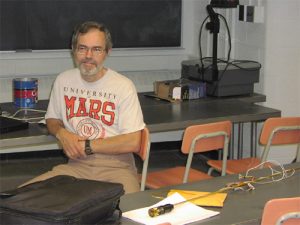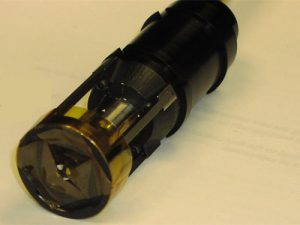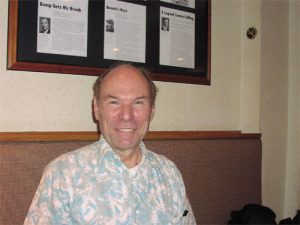Roger Tanner (Lowbrows): Prototype of a new Mars Camera
On July 26, 2002 we had a special meeting of the Lowbrows. Roger Tanner was the guest speaker. Until a few years ago, Roger was an engineer at Ford and an active member of the Lowbrows. That is, until he decided to devote more time to astronomy. He moved to Arizona with the goal of turning a hobby into a full time job. Since that time he has worked on several unmanned space missions. Roger comes back to Ann Arbor every so often, and this time he brought a prototype of a Mars Camera.
Roger had been given the assignment of designing a camera that may be part of a mission to Mars. I say “may be” because this is one of several possible missions, only one of which will be selected. If it is selected, a spacecraft will be launched in 2007 that will carry a group of identical landers. Each lander will be about the size of a coffee can and will be sent to landing sites evenly distributed across the Martian surface. Each lander will contain, among things, one of Roger’s cameras. These cameras will produce images of everything visible within a 360-degree radius. A single circular image will show everything on the ground and in the sky. The purpose of the camera is to detect changes in the atmosphere over a period of several years.
Roger discussed a number of issues involved with sending a spacecraft to Mars. First of all the equipment must be able to withstand the acceleration of launch. It then must deal with radiation, large temperature changes and the deceleration of the landing. The craft also needs to deal with dust. Martian dust is everywhere, and is a continual problem facing anyone involved with Mars exploration. The dust potentially can get into anything that lands on the Martian surface and possibly damage it.
Many of these issues can be tested on the ground, including how equipment reacts to temperature changes and exposure to radiation. However it is hard to test how some pieces of equipment will react to the dust. We know the dust has the form of a very fine-grained powder. It is probably made of iron oxides along with some other material, but the exact composition is not known. The dust can potentially stick to the surfaces of camera lenses, which could distort the images. Since the camera is supposed to function for several years, accumulated dust could be a problem. The cameras aboard the Viking Landers rotated in a “jerky” fashion that probably helped dislodge any accumulated dust. This will not help Roger’s proposed camera, since it has no moving parts. The lens of the camera is made of conductive material and is contact with the metal skin of the craft. It is hoped that this will electrically ground the lens and prevent it from accumulating a static charge that could attract dust. Even if some dust sticks to the lens, he felt that the dust is likely to accumulate in a random fashion and probably would not affect the data collection process.
Because budgets for space missions are tight, weight must be kept to an absolute minimum (each pound dramatically increases the cost of a mission). Using careful design, the electronics were simple and used minimal power. This resulted in a lighter spacecraft. The camera fits onto a single chip surface mounted onto a circular circuit board. Other types of cameras would have given more resolution, but would have required more circuitry. The computer and the camera use the same voltage supply, which reduces weight. The computer was designed to wake up periodically, ask the camera to take a picture, record the image and go back to sleep. Periodically it uploads data to the orbiting spacecraft that in turn forwards it to earth. It had an ephemeris to determine the best time to transmit. This minimizes transmission time (which is big power drain). If the lander cannot talk to the orbiter, it will continue to save data until it can. Even if an orbiter completely failed, the lander will keep saving data until a new orbiter could take its place.
There was also a brief discussion of manned Mars missions. Roger felt such a mission was still years into the future. However recent indications of water ice on Mars would make a Mars mission much easier (astronauts would not have to bring as much water with them, water would add to the weight and the cost of a possible manned mission). It also means that a supply of oxygen is available (it is easy to produce oxygen if you have a plentiful source of water). Oxygen would be used for breathing and as an oxidizer; the rocket that would send the astronauts back to earth needs oxidizers of one form or another.
Roger’s talk was two months ago, so I asked Roger for an update, he sent me the following e-mail:
“I am writing up the project report. We are not doing any more work at present. We are waiting for the next round of selections to be announced in December. If we make it into the final 4 there, we will do more work on all the proposals we are on. Just wait and see. I have some other small projects to do for some research that the boss is doing. Other than that it’s pretty slow.”

Roger Tanner

The Mars Camera
Note
The above text was originally published in David Snyder. (October 2002). “Roger Tanner Comes Home.” Reflections of the University Lowbrow Astronomers, pp. 4-5. [Here]
Other Photos



Tom Ryan, Bob Gehrke and Brian Woodcock (shown above) attended Roger Tanner’s talk. The first photo was taken in the Dennison Building (where the talk took place), the other two photos were taken at the Brown Jug, a nearby restaurant.
Update
The Mars camera was flown on the Phoenix mission 5 years after Roger gave his talk. See also:
- Roger Tanner. (August 2003). “Phoenix Selected for 2007 Launch Opportunity.” Reflections of the University Lowbrow Astronomers, pp. 8-9. [Here]
- Phoenix Mission